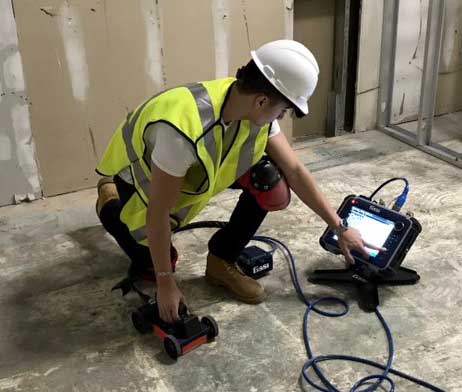Discovering the Depths: A Comprehensive Guide to Concrete Scanning and Its Diverse Applications
In the world of building and infrastructure growth, the thorough procedure of concrete scanning holds a pivotal role in guaranteeing the structural stability and safety of jobs. As modern technology proceeds to evolve, the applications of concrete scanning have expanded far beyond mere surface-level assessments.
Value of Concrete Scanning
Comprehending the importance of concrete scanning is essential in guaranteeing the security and stability of frameworks during building and construction and restoration tasks. Concrete scanning utilizes advanced modern technologies such as ground-penetrating radar (GPR) and electro-magnetic induction to find embedded objects, voids, or various other anomalies within concrete structures.
Furthermore, concrete scanning plays a critical function in guaranteeing compliance with building codes and laws that mandate the security of existing architectural components during construction activities. By properly mapping out the interior composition of concrete, scanning innovations enable building and construction experts to make informed decisions that promote the structural security and durability of structures and infrastructure jobs. Fundamentally, the significance of concrete scanning exists in its ability to secure both the architectural integrity and the employees associated with building undertakings.
Technologies Used in Concrete Scanning
Concrete scanning counts on advanced innovations such as ground-penetrating radar (GPR) and electro-magnetic induction to accurately discover embedded things and abnormalities within concrete structures. Ground-penetrating radar runs by sending out high-frequency electromagnetic waves right into the concrete.
Electro-magnetic induction, on the various other hand, works by generating magnetic fields around a concrete framework with a transmitter coil. When metal objects are present within the concrete, they disrupt these electromagnetic fields, creating eddy currents to flow through the metal. By determining the modifications in the magnetic fields with a receiver coil, the system can identify the area of metal things in the concrete.
These innovative modern technologies play a crucial function in non-destructive screening, guaranteeing the safety and honesty of concrete frameworks in various sectors.
Applications in Building Sector
Within the building and construction industry, concrete scanning technology discovers varied applications that enhance job effectiveness and safety and security. Furthermore, concrete scanning is made use of for locating voids, such as air pockets or locations of degeneration within concrete, which can compromise the total strength of a framework. Concrete scanning plays a vital duty in top quality control by confirming the thickness of concrete covers over support, guaranteeing conformity with style specifications and standards.

Safety And Security Benefits of Concrete Scanning
In the world of building safety, the application of concrete scanning technology offers a vital benefit in preemptively identifying prospective dangers and strengthening structural stability. By making use of advanced scanning techniques such as ground-penetrating radar (GPR) and electro-magnetic induction, building and construction teams can accurately locate rebar, post-tension wires, avenues, and various other hidden objects within concrete frameworks. This positive approach considerably lowers the danger of unexpected strikes during exploration, reducing, or coring tasks, thereby preventing costly problems, injuries, and job delays.
Moreover, concrete scanning click here now boosts employee safety and security by supplying real-time information about the architectural problem of concrete components. By resolving possible security problems promptly, concrete scanning contributes to creating a safe functioning atmosphere and minimizing the likelihood of structural failures or accidents on building websites.
Future Fads in Concrete Scanning
Emerging developments in scanning modern technology are poised to change the field of concrete examination and evaluation. One significant pattern that is getting grip is the assimilation of expert system (AI) and artificial intelligence formulas into concrete scanning gadgets. By harnessing the power of AI, these systems can evaluate vast quantities of data collected throughout scanning processes to offer more in-depth and exact insights right into the condition of concrete structures. This can help in detecting concealed problems, anticipating prospective structural failures, and even advising maintenance methods.
Another considerable fad is the advancement of more straightforward and mobile scanning tools. Miniaturization of scanning equipment click to read enables much easier accessibility to constrained areas and remote places, making assessments a lot more reliable and detailed. Furthermore, improvements in cordless communication modern technologies enable real-time data transfer and analysis, promoting quicker decision-making procedures.
In addition, there is a growing emphasis on sustainability in concrete scanning modern technologies - RainierGPR Concrete Scanning. Makers are significantly incorporating environment-friendly materials and energy-efficient attributes into their devices to decrease environmental impact. These future fads are established to boost the efficiency, precision, and sustainability of concrete scanning practices, shaping the market's future landscape
Final Thought
In verdict, concrete scanning plays a vital duty in the construction market by ensuring the safety and security and effectiveness of numerous tasks. As innovation advancements, the future of concrete scanning holds appealing advancements for improving building processes.
